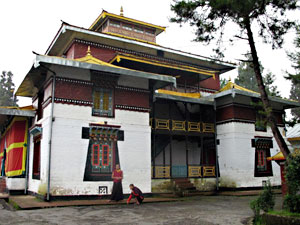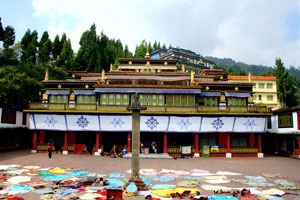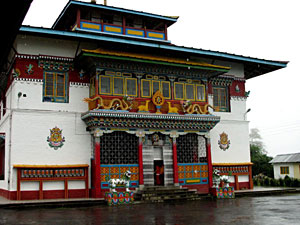|
|
|
Sikkim
Monasteries |
|
|
|
Monasteries in Sikkim
There are about 200 monasteries in Sikkim. The famous
monasteries in Sikkim are the Tsuk-La-Khang Monastery, Enchey
Monastery, Rumtek Monastery, Phodong Monastery, Pemayangtse
Monastery and Tashiding Monastery. Besides these monasteries
there are also some less known monasteries in Sikkim. These
monasteries belong either to the Nyingmapa sect or the Karugpa
sect or Gelugpa, Sakyapa and Bon faith. |
|
|
|
Enchey Monastery
Enchey monastery is one of the most important
monasteries of Sikkim. The Enchey Monastery meaning the
Solitary temple, was originally built with the solace
that no other construction would be allowed near it. The
Enchey monastery is constructed on a site blessed by
Lama Druptob Karpo. Lama Drupthob Karpo is supposed to
have built a small hermitage at the spot he reached
after he flew from Maenam Hill in South Sikkim. Later
during the reign of Sidyong Tulku 1909 - 1910 the
present monastery was built. This 200 year old monastery
has in its premises images of god, goddesses and other
religious objects. The present monastery was built in
the shape of a Chinese |
 |
|
|
Pagoda. This
monastery is located close to the Sinolchu Tourist Lodge and
the TV Tower in a dense wood and one can view the
Kanchendzonga range over the crown of trees. The monastery
follows the Nyingma Order and the main Puja and 'Chaam' or
religious masked dances are held here on the 18th and 19th day
of the twelfth month of the lunar calendar around January.
More...
Tsuk-La-Khang Monastery
Tsuk-La-Khang Monastery is located in the Palace premises near
the Ridge in Gangtok. Tsuk-La-Khang monastery is a two storied
monastery and and is the principal place of worship and
assembly and the repository of a vast collection of Buddhist
scriptures. This monastery was used during royal functions
like weddings and coronations. Interiors of this building is
covered with murals and lavishly decorated altars holding
images of the Buddha, Bodhisattva and tantric deities. A
magnificent portal breaks the starkness. At each corner of the
building, is a wood sculpture relief, the formidable head of a
snow lion. Resplendent Buddhist murals span the stoutly ornate
wood of the wall, while the eternal butter lamp burns before
the floor ceiling altar. The Phang Labsol and the Loosang
festivals are celebrated in the ground adjacent to the
monastery once in a year when the Chaams or the masked dances
are performed. The chapel is the site of many festivals and
the most interesting of them being one dedicated to the God of
Khangchendzonga. The other important festival is the
celebration of New Year, when the famous Black Hat dance is
performed demonstrating the triumph of good over evil.
Tashiding Monastery
Tashiding monastery is located on the top of a conical hill,
near Pemayangtse, about 40 kms. from Gyalshing. This monastery
is the Sikkim’s most venerated shrine. The Tashiding Monastery
was built in 1717. At first only a small Lhakhang was built by
Ngadak Sempa Chempo in the 17th Century. The main monastery
was built by Pedi Wangmo during the reign of Chakdor Namgyal
and some of the statues built then still exist. The sacred
objects of worship in Tashiding are the chorten Thongwa
Rangdol and Bumchu (holy water). The chorten was built by the
Lhatsun Chenpo and it is believed that merely to view the
chorten is enough to cleanse one of all sins. The countless of
prayer flags whisper in the air as one approach this holiest
site. The word "Om Mani Padme Hum" written on these prayer
flags fills the air. In the spring season thousands of
Buddhists visit the Tashiding monastery to participate in the
Bhumchu festival and sip the sacred water from a sacred Bhumpa
(water vessel), filled with waters collected from the Rahthong
and Rangit rivers. |
|
|
|
Rumtek Monastery
The Rumtek monastery is located on a hill, about 24 kms
from Gangtok. This monastery is said to be a replica of
the Tsurphu monastery of the Kagyupa order in Tibet. The
first monastery was built at Rumtek in 1717 but crumbled
to ruins due to aging. The second monastery was
constructed by his Holiness, the Gyalwa Karmapa in 1960.
The monastery belongs to the Karmapa Sect of Buddhism
and is the largest monastery in Sikkim. This monastery
has beautiful traditional architecture, carved and
painted woodwork, magnificent murals, manuscripts and
icons. The annual dances also |
 |
|
|
called the
Tse-Chu Chaams are held on the 10th day of the 5th month of
the Tibetan calendar around June. Dances called the Kagyat are
also held here on the 28th & 29th day of the tenth month of
the lunar calendar.
More...
Sanga Choeling Monastery
Sanga Choeling means 'the island of esoteric teaching'. This
monastery was built in 1697 and is situated after only 45
minutes walk from Pelling, about 7 kms. from Pemayangtse.
Sanga Choeling monastery is one of the second oldest gompas in
Sikkim. This gompa is another of Lhatsun Chenpo's creations,
and is highly venerated among the Nyingmapa.
Labrang Monastery
Labrang monastery is situated in North Sikkim, built 2 kms
further up hill from Phodong Monastery on the North Sikkim
Highway. This monastery was built in 1814 but belongs to the
Nyingmapa sect. This is a much older structure. It is also
unique in the sense that unlike most monasteries which were
razed by fires, this one still retains the original structure.
It is also one of the premier monasteries of Sikkim. Gyalshe
Rigzing Chempa commissioned Labrang Monastery in 1814, who
then resided in Wangdiche, a palace in the vicinity. Its name
literally means "the Lamas dwelling". It was consecrated to
the memory of Latsun Chembo of Kongpu of Tibet, who initiated
and propagated this school of Buddhism in Sikkim. Just below
the road between the Phodang and Labrang Monastery are the
ruins of Tumlong, the third capital of Sikkim
Kwezing Monastery
Kwezing Monastery is located near Kwezing in South Sikkim. It
was built during the reign of Chogyal Thutob Namgyal.
Simik Monastery
Simik Monastery is situated in the East District near Singtam
town. It was built during the reign of Chogyal Tsudphud
Namgyal.
Hee Gyathang Monastery
Hee Gyathang Monastery is located in North Sikkim and follows
the Nyingma sect of Buddhism.
Khechopari Monastery
Khechopari Monastery is located just above the famous
Khechopari lake near Yuksom.
Melli Monastery
Melli basically means 'a lepcha village'. This monastery is
located near Yuksom.. |
|
|
|
Pemayangtse Monastery
Pemayangtse Monastery is situated about 6 kms from the
Gyalsing town, about 140 kms. from Gangtok in Pelling,
West Sikkim. It is one of the most important monastery
of the Nyingmapa order and was first built as a small
temple in the late seventeenth century by Latsun Chempo.
Later during the reign of the third Chogyal Chakdor
Namgyal, Jigme Pawo extended and rebuilt the structure
in the form of a big monastery. It is perched at a
height of 2085 mts and is the second oldest and perhaps
the most important monastery in Sikkim. This monastery
belongs to the Nyigma order and all other Nyigma order
monasteries in Sikkim are subordinate to it. The
monastery houses numerous religious idols and
|
 |
|
|
other objects
of worship, most of which are priceless. On the top floor of
the monastery there is a wooden sculpture portraying the
Mahaguru’s Heavenly Palace Sangthokpalri. This master piece
was completed by the late Dungzin Rimpoche, who took five
years to craft it single handed. The main festival of the
monastery is celebrated on the 28th and 29th day of the 12th
month of the Tibetan calendar, in the month of February.
During these two days religious dances are performed and
pilgrims come from all over Sikkim to watch them. Dressed in
costumes of rare magnificence, the Lamas represent Mahakala
and Guru Drag-dmar. The dance ends on the third day with the
unfurling of the `Ghyo- ku' - a gigantic embroidered Buddhist
scroll as the devotees bend down in homage.
Sinon Monastery
Sinon means 'the suppressor of intense fear'. The monastery
was built in 1716 and located about 10 kms. from Tashiding on
a hill top.
Dalling Monastery
Dalling means 'the thunderbolt'. This monastery was built in
1840 and situated near Kewzing in South Sikkim.
Yangyang Monastery
Yangyang means 'the ridge of fortune'. This monastery was
built in 1840 and is situated at a place called Yangyang, 10
kms. from Rabangla.
Namchi Monastery
This monastery is located in Namchi, the district headquarters
of south district and was constructed during the reign of
Chogyal Gurmed Namgyal.
Chawayng Ani Monastery
This monastery is located near Phensang which is on the
highway between Gangtok and Mangan. It was built during the
reign of Chogyal Tshudphud Namgyal. |
|
|
|
Phodong Monastery
Phodong monastery is located within an area of one
square kilometer and about 40 kilometers from Gangtok on
the North Sikkim Highway. Phodong Monastery belongs to
the Karugpa Sect (Karmapa) and was built by the Chogyal
Gyurmed Nammgyal in the first quarter of the eighteenth
century. It is said to be the first Kagyupa monastery to
be set up in Sikkim. It is famous for its exquisitely
delicate mural painting and frescoes. The original
monastery has been rebuilt and is today one of the most
beautiful monasteries in Sikkim. It possesses the old
mural paintings and has around 260 monks. The main
annual puja is performed on the 28th and 29 day of
|
 |
|
|
the tenth month of the Tibetan
calendar in which the religious Chaams or dances are
performed.
Karthok Monastery
Karthok Monastery is located in East Sikkim near Pakyong,
about 32 kms. from Gangtok. The present structure of the
monastery was built during the reign of Chogyal Thutob Namgyal.
Karthok Monastery is the sixth oldest monastery of Sikkim, an
important seat of the Nyingma Order. The original monastery
was destroyed and a new one is built in its place. The unique
architectural design of the original was, however, retained.
Bermoik Monastery
Bermoik Monastery was built in 1952 and follows the Nyingma
sect of Buddhism. It is situated in South Sikkim above Singtam.
Lachen Monastery
Lachen Monastery was built in 1806 in North Sikkim and follows
the Nyingma sect of Buddhism.
Lachung Monastery
Lachung Monastery was built in 1880 in North Sikkim and also
follows the Nyingma sect of Buddhism.
Sang Monastery
Sang Monastery is situated in a small village called Sang near
Rumtek in 1912. |
|
|
|
Dubdi Monastery
Dubdi means 'the retreat'. Dubdi Monastery, one of the
oldest monastery in Sikkim, is located at the hill top
about an hour's walk from Yuksom. This monastery was
built in 1701. This monastery is also known as the
Hermit's Cell after its reclusive founder Lhatsun Namkha
Jigme, it was built by the followers of the Nyingmapa
sect of Tibetan Buddhism. For bird watchers, an early
morning or late afternoon visit is particularly
rewarding.
Gnathang Monastery
Gnathang Monastery is the only Gelugpa monastery in
Sikkim and is situated near the Tibetan border. |
 |
|
|
|
|
Shurishing
Yungdrung Dungdrakling Monastery
Shurishing Yungdrung Dungdrakling Monastery is situated in
Sosing in South Sikkim. This is the only monastery in Sikkim
that follows the Bon faith. |
|